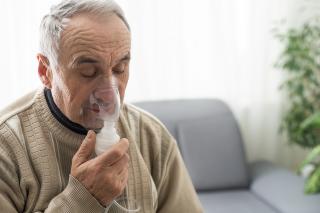Over 130 million Americans have at least one chronic condition. According to the U.S. Centers for Disease Control, chronic conditions are defined as conditions that last one year or more and require ongoing medical attention or limit activities of daily living. As you get older, your risk for developing chronic conditions increases significantly, and many older adults live with multiple chronic conditions that impact their well-being and quality of life. One such chronic condition is called COPD, or Chronic Obstructive Pulmonary Disease.
What is COPD?
Chronic Obstructive Pulmonary Disease (COPD) is characterized by inflamed airways and damaged tissue that restrict the flow of oxygen in and out of your lungs. This results in organs and tissues receiving less oxygen than they need to function optimally, and an inability to completely rid the body of carbon dioxide, the gas we expel when we exhale. As the disease progresses, shortness of breath becomes more frequent and can inhibit the ability to remain physically active. Often, COPD can also be characterized by a patient having chronic bronchitis, emphysema, or both. Luckily, not only can COPD be treated, but it can also be prevented.
Women Have a Higher Risk of Death from COPD
COPD is one of the leading causes of disability and early death in the United States and affects women at a higher rate than men. The rise of the tobacco industry in the 1960s, which feminized their cigarette ads to specifically target women, combined with women being more vulnerable than men to the damage caused by smoke and environmental pollutants, could be to blame for the disparity.
While millions of Americans are diagnosed with COPD each year, millions more may be unaware that they have this chronic condition. As with most chronic conditions and diseases, early detection and awareness are key to successful treatment. Here’s what to look out for.
Don’t Miss These COPD Warning Signs and Risk Factors
Smoking (not just cigarettes). The majority of COPD deaths are caused by smoking cigarettes. While youth smoking dropped to an all-time low in 2021 and the global prevalence of cigarette smoking has certainly fallen, the rise in vaping can be just as detrimental to those with COPD. However, because research on vaping is still limited, there is not yet any data to support that vaping can cause COPD. One study found that heavy marijuana smokers also have a significantly increased risk of developing COPD. Still, current cigarette smokers who quit now can decrease their risk of developing COPD, even if they’ve been longtime smokers. Smoking cessation is the only effective treatment for avoiding or reducing the progression of COPD.
Environmental pollutants. No matter what we do to limit our exposure to toxins, some exposure to environmental pollutants is outside of our control. The quality of the air we breathe every day can play a role in developing COPD. And long-term exposure to air pollution, secondhand smoke, dust, fumes, and other chemicals (such as work-related chemicals and fumes in certain industries) can cause and exacerbate COPD.
Genetics. Our bodies produce an immune-boosting protein called Alpha-1 that protects the body’s tissues against infectious pathogens. A small number of people may develop a rare form of COPD called alpha-1 deficiency-related emphysema caused by a genetic inability to produce this alpha-1 protein.
Living with COPD: 2 Ways to Improve Your Quality of Life
Living with COPD is possible, especially if you take proactive steps to improve your health and well-being. Here are a few tips to optimize your physical and mental health if you have COPD.
Reduce stress. There is not a single disease that stress doesn’t exponentially worsen. Lungs are major immune organs that protect you from diseases caused by pathogen inhalation, allergens, and xenobiotics. Stress can cause more rapid breathing and panic attacks, causing you to overexert your lungs. Learning to manage stress and anxiety by coping with emotions, seeking therapy from a trusted practitioner, engaging in mindfulness or breathing techniques, and practicing self-care can help reduce stress levels and avoid additional damage to your compromised lungs and airways.
Focus on nutrition. Hippocrates once said, “Let thy food be thy medicine.” The foods we consume make us more or less healthy. Choosing whole, nutrient-dense foods at every meal can help you breathe easier and feel better, mentally and physically. A low-carb diet can also improve the quality of life for someone living with COPD, as the metabolism of carbohydrates produces the most carbon dioxide for the amount of oxygen used. The American Lung Association recommends a diet high in fiber, low in simple carbohydrates, and limiting trans-fats like butter, lard, or fried foods. Even making small changes like eating a balanced, nutritious breakfast within an hour of waking can make a noticeable difference in how much better you feel.
To prevent or reduce your risk of developing COPD or to decrease the severity of symptoms, it is recommended to stop smoking and avoid exposure to secondhand smoke. If you do smoke, do not smoke indoors.




